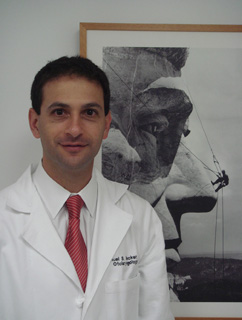
|
|
Vol. LXV, No. 11
|
Wednesday, March 16, 2011
|
 SOUND SLEEP: “Obstructive sleep apnea (OSA) can affect all the organs of the body and is associated with serious problems, such as strokes, heart attacks, high blood pressure, and diabetes. More and more people are getting treated for it today.” Samuel Becker, M.D., founder and medical director of the New Jersey Center for Snoring and Sleep Apnea, looks forward to helping more patients with OSA. |
Sleep that knits up the ravel’d sleeve of care,/
The death of each day’s life, sore labor’s bath,/
Balm of hurt minds, great nature’s second course,/
Chief nourisher in life’s feast.
So wrote William Shakespeare in Macbeth, and many people today can identify with the thoughts expressed. More people than ever complain of being sleep-deprived in our high tech, demanding, and constantly connected society. And, now, in addition to not having time to get enough sleep, increasing numbers of people are being diagnosed with Obstructive Sleep Apnea (OSA).
Headaches, awakening with a sore or dry throat, and still feeling tired, daytime fatigue, including falling asleep at work or while driving — these can all be symptoms of OSA, a condition that is widely prevalent, and that many people do not even know they have. In fact, it is said that 18 million Americans suffer from sleep apnea, and 90 percent of them are undiagnosed.
Manageable Condition
“I want to emphasize the prevalence of this problem and that is a diagnosable and manageable condition,” says Samuel Becker, M.D., founder and medical director of the New Jersey Center for Snoring and Sleep Apnea at 800 Bunn Drive.
“When the flow of air stops completely during sleep (reduced for at least 10 seconds), this is known as an apnea,” explains Dr. Becker in his new book Snoring and Obstructive Sleep Apnea: Patient’s Guide to Minimally Invasive Treatments. “When this abnormal event (apnea) is due to obstructive anatomic causes — often related to the collapse or blockage of the upper airway — a patient is considered to have Obstructive Sleep Apnea or OSA.” These interruptions in breathing can happen many times during the night, he adds.
Board-certified by the American Board of Otolaryngology, Dr. Becker holds appointments at top research institutions for nose and sinus disease, including the University of Pennsylvania and Vanderbilt University. He is also one of the few otolaryngologists in New Jersey who is fellowship-trained in the diagnosis and treatment of sinonasal disorders. He has offices in Sewell and Voorhees as well as Princeton.
Now, he is bringing his skills to help patients with OSA. Diagnosis is usually based on the results of patient evaluation and history, and an overnight sleep study, called a Polysomnogram (PSC), which can be done at a sleep center or at home.
Anatomical Causes
“The first step is always to listen to the patient, followed by an examination,” explains Dr. Becker. “There can be anatomical causes.”
Snoring can be a symptom of sleep apnea, and is widespread, believed to affect as many as 50 percent of adults — both men and women — more than 45 million Americans. Many patients who snore may have sleep apnea; many patients who have sleep apnea snore, says Dr. Becker.
When a patient has been diagnosed with sleep apnea, various treatments are available, depending on whether the condition is mild, moderate, or severe. Treatments can sometimes start with weight loss and increased exercise. Others include medical treatments, such as Continuous Positive Airway Pressure (CPAP), Oral Appliance Therapy, Pillar Procedure, and surgery.
CPAP is pressurized air generated from a bedside machine. The air is delivered through a tube connected to a mask covering the nose and/or mouth, and the force of pressurized air causes the airway to open.
“The CPAP device is a good treatment. It works well if people can tolerate the mask,” points out Dr. Becker.
Not everyone is able to handle being hooked up to a machine with a mask over the nose or mouth, however, and oral appliances are another treatment. Similar to a dental appliance, such as an orthodontic retainer or night guard, they help to move the lower jaw forward and decrease the likelihood of the oral soft tissues collapsing and obstructing the airway.
Soft Palate Implants
Another type of oral appliance is a tongue retaining device, which applies suction to the tongue at night to help it from falling back into the throat.
“A newer, minimally-invasive, and very effective method is the pillar procedure,” says Dr. Becker. “Three to five soft palate implants are inserted into the soft palate of appropriate patients. Performed under local anesthesia, it takes 20 minutes in the office. Studies have shown both a significant decrease in patient snoring and OSA symptoms, such as day-time sleepiness, after treatment with implants.”
Radiofrequency treatments are still another minimally-invasive means to treat OSA and snoring. In more serious situations, surgery may be indicated. “Surgery is another possibility if it is necessary to open the nasal passage or oral airway or to repair a deviated septum,” adds Dr. Becker.
He points out that sleep apnea affects all ages, and while snoring does increase with age, it is also seen in younger people, including children.
Treating sleep apnea is a growing part of his practice, and there is more and more investigation into it all the time. “The challenge is finding the appropriate treatment for each individual, and I look forward to more good treatment options becoming available. We are really able to change people’s lives, help them change their quality of life in a positive way, and actually increase their longevity.”
Dr. Becker’s book Snoring and Obstructive Sleep Apnea: Patient’s Guide to Minimally-Invasive Treatments is available free on-line: www.njsnoresleep.com (609) 430-9200.